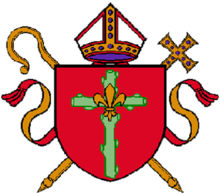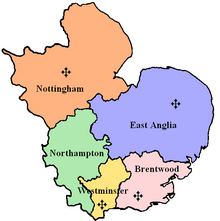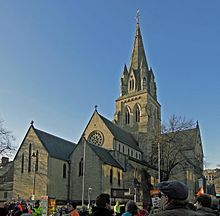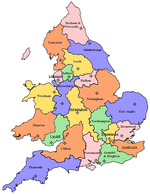Roman Catholic Diocese of Nottingham
Diocese of Nottingham Dioecesis Nottinghamensis | |
|---|---|
 | |
| Location | |
| Country | England |
| Territory | Counties of Derby, Leicester, Lincoln, Nottingham, Rutland and Northern Lincolnshire except parts of the High Peak and Chesterfield district of Derby and the district of Bassetlaw in Nottingham. |
| Ecclesiastical province | Westminster |
| Metropolitan | Diocese of Westminster |
| Deaneries | 13 |
| Statistics | |
| Area | 13,000 km2 (5,000 sq mi) |
| Population - Total - Catholics (including non-members) | (as of 2013) 4,500,000 155,000 (3.4%) |
| Parishes | 108 |
| Information | |
| Denomination | Catholic |
| Sui iuris church | Latin Church |
| Rite | Roman Rite |
| Cathedral | Nottingham Cathedral |
| Secular priests | 130 |
| Current leadership | |
| Pope | Francis |
| Bishop | Patrick McKinney |
| Metropolitan Archbishop | Cardinal Vincent Nichols |
| Vicar General | Very Rev. Canon Edward Jarosz VG Very Rev. Fr. Joseph Wheat VG |
| Episcopal Vicars | Very Rev. Fr. Paul Chipcase Very Rev. Fr. Martin Hardy Very Rev. Fr. Michael Moore Sr. Susan Richert |
| Judicial Vicar | Very Rev. Fr Peter Vellacott |
| Map | |
 Diocese of Nottingham within the Province of Westminster | |
| Website | |
| dioceseofnottingham.uk | |
The Diocese of Nottingham, England, is a Roman Catholic diocese of the Latin Rite and a suffragan in the ecclesiastical province of the Metropolitan Diocese of Westminster.
The diocese covers an area of 13,074 square kilometres (5,048 sq mi), taking in the English counties of Nottinghamshire (now excluding the district of Bassetlaw), Leicestershire, most of Derbyshire, Rutland and Lincolnshire. The episcopal seat is the Cathedral Church of St Barnabas in Nottingham.
The Right Reverend Patrick McKinney is the 10th Bishop of Nottingham.
History[]

It was one of twelve English dioceses created at the restoration of the hierarchy by Pius IX in 1850, embracing the counties of Nottingham, Leicester, Derby, Lincoln and Rutland. These had comprised part of the Apostolic Vicariate of the Midland District, when at the request of King James II in 1685, the Holy See divided England into four vicariates: the London, the Northern, the Midland and the Western. Before 1840, when the number of vicars apostolic was increased from four to eight, the Midland District consisted of fifteen counties.[1]
In 1850 Nottingham had 24 permanent missions, many of these little better than villages. For the most part they originated from chaplaincies which had through penal times been maintained by the Catholic nobility and gentry, or had been founded independently by them. Among these there existed foundations of several religious orders. In Derbyshire the Jesuits had missions at Chesterfield and Spinkhill, in Lincolnshire at Lincoln, Boston and Market Rasen. The Dominican Order was settled in Leicester, the Fathers of Charity carried on several missions in Leicestershire, and the Cistercians occupied Mount St Bernard Abbey in Charnwood Forest.[1]
From the appearance of the Jesuits in England in 1580 at the special request of Dr William Allen, they had done much by their labours to keep alive the Catholic faith in the Nottingham diocese. Of their missions mentioned above some were among the earliest of the Society of Jesus in England dating back some three hundred years. Derby was included in the district or college of the Society called the "Immaculate Conception", founded by Father Richard Blount, about 1633, first provincial superior of the English Province. Extinct for many years, it was partially revived in 1842 as Mount St Mary's College, when the new college and convictus was established by the then provincial, Father Randall Lythgoe.[1]
After the Reformation, the English Province of the Friars Preachers ceased to exist, until resuscitated at Bornem in Flanders by Philip Howard, later cardinal, who became the first prior of the Dominicans in 1675. The first introduction of the English Dominicans from Bornem was at Hinckley, whence for many years Leicester was served by them at intervals. Their mission at Leicester was put on a permanent basis in 1798 by the purchase of a house by Father Francis Xavier Choppelle. Holy Cross Priory, Leicester was begun by Father Benedict Caestryck in 1815 and was opened in 1819. The dedication under the title of Holy Cross was adopted on account of the celebrated relic of the Holy Cross brought from Bornem.
After the lapse of three centuries a monastery of the Cistercian Order was resuscitated in England by the foundation of the Abbey of Mount St Bernard in Leicestershire, made possible by the assistance of Ambrose Phillips de Lisle of Grace Dieu Manor, who after his conversion in December 1825, devoted his energies to the spread of the Catholic faith in England by the re-establishment in the country of monastic institutions. In 1835 he purchased about 227 acres (0.92 km2) of wild uncultivated land in Charnwood Forest and presented it to the Cistercians.[2]
Beginning with one brother who lived alone in a four-roomed cottage, the community rapidly increased, and a larger building was erected as well as a small chapel, opened by Dr Walsh on 11 October 1837. In a short time this proved insufficient and John Talbot, 16th Earl of Shrewsbury offered them £2,000, on condition that a new monastery should be erected, choosing for that purpose the present site of the abbey. It was built from designs by Augustus Pugin. In 1848 by Papal Brief of Pius IX the monastery of Mount St Bernard was raised to the dignity of an abbey, and Father Bernard, the first mitred abbot in England since the Reformation, was consecrated on 18 February 1849.
In introducing the Cistercians into England, de Lisle had hoped that they would undertake missionary work and with this view he had built three chapels: at Grace-Dieu, Whitwick and the abbey. On the score of their rule, they declined to take charge permanently of the missions. De Lisle then decided to bring from Italy members of the Institute of Charity. After much negotiation with the head of the order, Father Gentili came to Grace Dieu as chaplain. This was the commencement of the settlement of the Rosminians in the diocese. In 1841 Dr Walsh made over to them the secular mission of Loughborough founded in 1832 by Father Benjamin Hulme. The buildings were too small to permit of a novitiate and a college of their own which they were desirous to establish. To carry out this twofold object, about 9 acres (36,000 m2) were purchased; the foundation stone of the new buildings was laid in May 1843 and in 1844 was opened the first college and novitiate house of the institute in England. The Sisters of Mercy had come to Nottingham in 1844, and in 1846 entered their convent in close proximity to the cathedral.
The first Bishop of Nottingham was the Rt Rev. Joseph William Hendren, O.S.F. (born 1792), consecrated on 10 September 1848, as Vicar Apostolic of the Western District, transferred to the bishopric of Clifton on 29 September 1850, and to Nottingham on 22 June 1851. The cathedral church of St Barnabas, of the lancet style of architecture, is considered one of the best specimens of the work of Pugin.
Owing to ill-health Dr Hendren resigned in 1853 and was succeeded by Dr Richard Roskell, born at Gateacre, near Liverpool, in 1817. He was sent to Ushaw College and afterwards to Rome, where he took his degree and was ordained in 1840. He was consecrated in the cathedral by Cardinal Wiseman on 21 September 1853. During his episcopate a number of missions were founded in the counties of the diocese. In Lincolnshire, through the generosity of Thomas Arthur Young of Kingerby Hall, not only was there a church and presbytery built at Gainsborough and Grimsby, but the Premonstratensian order was re-introduced into England at Crowle and Spalding. Thomas Young also planned to build a church in Lincoln, but it was not until 1893 that St Hugh's Church, Lincoln was opened.[3]
In 1874, owing to Dr Roskell's ill-health, the pope appointed the Rev. Edward Gilpin Bagshawe of the London Oratory his coadjutor. The same year, Dr Roskell tendered his resignation and Dr Bagshawe was consecrated at the London Oratory on 12 November 1874. Numerous missions necessitated by the development of the mining industry were opened during his administration, and communities of nuns introduced into the diocese, which he served for 27 years. He resigned in 1901 and in 1904 was transferred to the titular Archbishopric of Seleucia.
The Rt Rev. Robert Brindle, Bagshawe's successor, was born at Liverpool on 4 November 1837. The first Roman Catholic chaplain to receive the pension for distinguished and meritorious service, as well as Turkish and Egyptian orders and medals, he was, after his retirement from the army in 1899, on the petition of Cardinal Herbert Vaughan, third Archbishop of Westminster, appointed his assistant, and on the resignation of Dr Bagshawe, received his Brief to the See of Nottingham on 6 November 1901.
In 1910 there were in the diocese 32,000 Catholics; 84 secular and 44 regular priests; 75 churches with missions attached, 31 without missions; 6 convents for men and 9 for women.
In 1980, 16 parishes were transferred to the newly created Diocese of Hallam; this resulted in Bassetlaw in Nottinghamshire and Chesterfield and parts of the High Peak in Derbyshire ceasing to be part of the diocese.
Bishops[]
Past and present ordinaries[]
- Joseph William Hendren, O.F.M. Rec. (1851-1853)
- Richard Butler Roskell (1853-1874)
- Edward Gilpin Bagshawe, C.O. (1874-1901)
- Robert Brindle (1901-1915)
- Thomas Dunn (1916-1931)
- John Francis McNulty (1932-1943)
- Edward Ellis (1944-1974)
- James Joseph McGuinness (1974-2000)
- Malcolm Patrick McMahon, O.P. (2000-2014), appointed Archbishop of Liverpool
- Patrick Joseph McKinney (2015- )
Coadjutor bishops[]
- James Joseph McGuinness (1972-1974)
Other priests of this diocese who became bishops[]
- William Eric Grasar, appointed Bishop of Shrewsbury in 1962
- John Francis Sherrington, appointed auxiliary bishop of Westminster in 2011
- Cyril Edward Restieaux, appointed Bishop of Plymouth in 1955
Churches[]
Deanery of Amber Valley[]
The Deanery of Amber Valley encompasses several communities in the Amber Valley district of Derbyshire, including Alfreton, Clay Cross, Belper, Duffield, Hassop, Bakewell, Matlock, Ripley, and Wirksworth. Rev. Fr Michael Kirkham is the area dean.[4]
| Church name | Image | Location | Description | Sources |
|---|---|---|---|---|
| All Saints | 
|
Hassop Road, Hassop | Grade I listed church completed in 1817, designed by Joseph Ireland | [5] |
| Christ the King | 104 Nottingham Road, Alfreton | [6] | ||
| English Martyrs | Buxton Road, Bakewell | [7] | ||
| Our Lady and St Joseph | St Joseph Street, Matlock | [8] | ||
| Our Lady and St Teresa of Liseux | Gorsey Bank, Wirksworth | [9] | ||
| Our Lady of Perpetual Succour | 12 Gibfield Lane, Belper | [10] | ||
| St Joseph | 94 Butterley Hill, Ripley | [11] | ||
| St Margaret Clitherow | Hall Farm Road, Duffield, Belper | [12] | ||
| St Patrick and St Bridget | Thanet Street, Clay Cross, Chesterfield | [13] | ||
| The Briars | Briars Lane, Crich, Matlock | [14] |
Deanery of Derby[]
The Deanery of Derby encompasses the city of Derby and several surrounding communities, including Allestree, Normanton, Sinfin, Alvaston, Chellaston, Chaddesden, Mickleover, Mackworth, Ashbourne, and Borrowash. Rev. Fr Mark Brentnall is the area dean.[4]
| Church name | Image | Location | Description | Sources |
|---|---|---|---|---|
| All Saints | Ashborne | |||
| Christ the King | Mackworth | |||
| English Martyrs | Alvaston | |||
| Holy Family | Allestree | |||
| Holy Spirit | Sinfin | |||
| Our Lady of Lourdes | Mickleover | |||
| St Alban | Chaddesden | |||
| St Charles Borromeo | Hadfield | |||
| St Francis of Assisi | Long Eaton | |||
| St George and All Soldier Saints | Old Normanton | |||
| St Hugh | Borrowash | |||
| St Joseph the Worker | Winshill, Burton-on-Trent | |||
| St Joseph | Derby | |||
| St Mary Crowned | Glossop | |||
| St Mary | Derby | |||
| St Ralph Sherwin | Chellaston | |||
| Ss Peter and Paul | Swadlincote | |||
| The Church of the Risen Lord | Castle Donington |
Deanery of Fenland[]
The Deanery of Fenland encompasses Boston, Spalding, Holbeach, Skegness, Spilsby, and Sleaford. The area dean is the Rev. Fr Alex Adkins.[4]
| Church name | Image | Location | Description | Sources |
|---|---|---|---|---|
| Holy Trinity | Holbeach | |||
| Immaculate Conception and St Norbert | Spalding | |||
| Our Lady and the English Martyrs | Spilsby | |||
| Our Lady of Good Counsel | Sleaford | |||
| Sacred Heart | Skegness |
Deanery of Grantham[]
The Deanery of Grantham encompasses Bourne, Deeping St James, Grantham, Melton Mowbray, Oakham, Exton, and Stamford. The area dean is the Rev. Fr Stephen Dye.[4]
| Church name | Image | Location | Description | Sources |
|---|---|---|---|---|
| Our Lady of Lincoln and St Guthlac | Deeping St James | |||
| St Mary and St Augustine | 
|
Stamford | High Victorian Early English style designed by George Goldie, built 1862-64 | |
| St Mary the Immaculate | Grantham | |||
| Sacred Heart and St Gilbert's | Bourne |
Deanery of High Peak[]
The Deanery of High Peak encompasses Buxton, Chapel-en-le-Frith, Tideswell, Charlesworth, Gamesley, Hadfield, Glossop, Marple Bridge, and New Mills. The area dean is the Rev. Canon Daniel Bowdren.[4]
| Church name | Image | Location | Description | Sources |
|---|---|---|---|---|
| All Saints | Church Street, Glossop | [15][16] | ||
| Immaculate Conception | Charlesworth | |||
| St Anne | Buxton | |||
| St John Fisher and St Thomas More | Chapel-en-le-Frith | |||
| St Mary and the Annunciation | Marple Bridge | |||
| St Mary and the Annunciation | New Mills | |||
| The Immaculate Heart of Mary | Tideswell |
Deanery of Leicester[]
The Deanery of Leicester covers the city of Leicester and communities within and without the city, including: Braunstone, New Parks, Aylestone, Eyres Monsell, Wigston, Netherhall, Rushey Mead, Beaumont Leys, Knighton, Oadby, Birstall, Rothley, Market Harborough, Husbands Bosworth, Earl Shilton, Hinckley, Market Bosworth, Lutterworth, and Narborough.[4] The area dean is the Rev. Mgr. John Hadley.[17]
Deanery of Lincoln[]
The Deanery of Lincoln encompasses the city of Lincoln and the surrounding communities of Bardney, Louth, Mablethorpe, Market Rasen, Caistor, Hainton, Osgodby, Woodhall Spa, and Horncastle.
| Church name | Image | Location | Description | Sources |
|---|---|---|---|---|
| Holy Rood | 
|
Market Rasen | [18] | |
| Our Lady and St Joseph | Osgodby | |||
| Our Lady and St Peter | Woodhall Spa | |||
| Our Lady of Lincoln and St Guthlac | Deeping St James | |||
| Laughton Way, Lincoln | Parish serving the northern portion of Lincoln; foundation stone laid in 1963 and opened in 1964 | [19] | ||
| St Francis de Sales | Hainton | [20] | ||
| St Hugh of Lincoln | 90 Staverton Road, Bilborough | [21] | ||
| St Hugh of Lincoln | 
|
Lincoln | Gothic Revival church built between 1892 and 1893, designed by Albert Vicars | |
| St Joseph | Seaholme Road, Mablethorpe | [22] |
Deanery of Lindsey[]
The Deanery of Lindsey includes the communities Barton-upon-Humber, Brigg, Crowle, Gainsborough, Scunthorpe, Winterton, Grimsby, Cleethorpes, and Immingham. Rev. Fr Andrew Cole was the area dean.
| Church name | Image | Location | Description | Sources |
|---|---|---|---|---|
| St Mary of the Sea | Heneage Road, Grimsby | [23] |
Deanery of Loughborough[]
The Deanery of Loughborough covers the communities of Loughborough, Ashby-de-la-Zouch, Measham, Coalville, Melbourne, Castle Donington, Mount St Bernard Abbey, Shepshed, Sileby, Syston, Whitwick, Woodhouse Eaves, Burton upon Trent, and Swadlincote. The area dean is the Rev. Fr Peter Vellacott.
| Church name | Image | Location | Description | Sources |
|---|---|---|---|---|
| Divine Infant of Prague | Syston | |||
| Holy Cross | Whitwick | |||
| Mount St Bernard Abbey | 
|
Cistercian monastery founded in 1835 | [24] | |
| Our Lady of Lourdes | Ashby-de-la-Zouch | |||
| Our Lady of Mercy and St Philip Neri | Melbourne | |||
| St Charles Borromeo | Measham | |||
| St Gregory | Sileby | |||
| St Mary of the Annunciation | Loughborough | |||
| St Mary | Woodhouse Eaves | |||
| St Wilfrid of York | Coalville | |||
| St Winefride | Shepshed | |||
| Sacred Heart of Jesus | Loughborough |
Deanery of Nottingham East[]
| Church name | Image | Location | Description | Sources |
|---|---|---|---|---|
| Cathedral Church of St Barnabas | 
|
North Circus Street, Nottingham | Mother church of the Diocese of Nottingham; built between 1841 and 1844 | [25] |
| Good Shepherd | 
|
3 Thackerays Lane, Woodthorpe, Nottingham | Catholic church opened in 1964; Grade II listed building | [26] |
| Our Lady and St Edward | Nottingham | |||
| Our Lady and St Patrick, the Meadows | Launder Street, Nottingham | |||
| Our Lady of Grace | Cotgrave | |||
| Our Lady of the Angels | East Leake | |||
| St Anne | Radcliffe-on-Trent | |||
| St Augustine, Apostle of England | Nottingham | |||
| St Margaret Clitherow | Keyworth | |||
| The Good Shepherd | Arnold |
Deanery of Nottingham West[]
| Church name | Image | Location | Description | Sources |
|---|---|---|---|---|
| Holy Cross | Hucknall | [27] | ||
| Our Lady and St Thomas of Hereford | Ilkeston | [28] | ||
| Our Lady of Good Counsel | Eastwood | |||
| Our Lady of Perpetual Succour | Bulwell | |||
| St Hugh of Lincoln | Bilborough | |||
| St John the Evangelist | Stapleford | |||
| St Mary | Hyson Green | |||
| St Paul | Nottingham | |||
| St Teresa of Liseux | Aspley | |||
| St Thomas More | Wollaton |
Deanery of Sherwood[]
| Church name | Image | Location | Description | Sources |
|---|---|---|---|---|
| Holy Trinity | Newark | [29] | ||
| Our Lady Help of Christians | Kirkby-in-Ashfield | [30] | ||
| Our Lady of Victories | Southwell | [31] | ||
| St Anthony's | Calverton | [32] | ||
| St Bernadette's | Bolsover | [33] | ||
| St George | Rainworth | [34] | ||
| St Joseph the Worker | Sutton-in-Ashfield | [35] | ||
| St Joseph | New Ollerton | |||
| St Joseph | Shirebrook | |||
| St Patrick | Mansfield | |||
| St Ralph Sherwin | Chellaston | |||
| St Philip Neri | Mansfield | |||
| St Teresa | Market Warsop |
Sexual abuse in the diocese[]
In 2014, 85-year-old Father Francis Paul Cullen, who had served as a priest in the parishes of Hyson Green and Mackworth and Buxton in the diocese, admitted 21 sexual assault charges against two young girls and five altar boys. He had been on the run in Tenerife for 20 years. The offences took place over a 34-year period from 1957 to 1991 and involved children aged from six to sixteen.[36] A police spokesperson said that it was “inconceivable” that Cullen had not abused more children during his time as a priest. During the court case the diocese insisted there were no records of anybody complaining to the Church at the time, however at least one victim said their parents did report the abuse to the Church.[37]
In 2011 the Diocesan Safeguarding Co-ordinator reported that there had been "12 new concerns/allegations which needed to be dealt with" during the previous year, and that he welcomed the paring back of a Government Vetting and Barring Scheme.[38]
See also[]
- Notable churches in the diocese are listed at List of Roman Catholic churches in the United Kingdom#Nottingham
References[]
- ^ a b c Croft, William. "Diocese of Nottingham." The Catholic Encyclopedia Vol. 11. New York: Robert Appleton Company, 1911. 27 February 2019
- ^ Purcell, Edmund Sheridan. Life and Letters of Ambrose Phillipps de Lisle, p.66, Macmillan and Co., Ltd., London, 1900
- ^ Lincoln - St Hugh of Lincoln from English Heritage, retrieved 20 December 2015
- ^ a b c d e f "Parishes". Roman Catholic Diocese of Nottingham. Retrieved 12 April 2020. Source states incorrectly that Rushy Mead (a place in Essex) is one of its communities, when Rushey Mead (in Leicester) apparently meant.
- ^ "All Saints, Hassop". Diocese of Nottingham.
{{cite web}}: Missing or empty|url=(help) - ^ "Christ the King, Alfreton". Diocese of Nottingham. Retrieved 11 April 2020.
- ^ "English Martyrs, Bakewell". Diocese of Nottingham. Retrieved 11 April 2020.
- ^ "Our Lady and S. Joseph, Matlock". Diocese of Nottingham. Retrieved 11 April 2020.
- ^ "Our Lady and S. Teresa of Liseux, Wirksworth". Diocese of Nottingham. Retrieved 11 April 2020.
- ^ "Our Lady of Perpetual Succour, Belper". Diocese of Nottingham. Retrieved 11 April 2020.
- ^ "S. Joseph, Ripley". Diocese of Nottingham. Retrieved 11 April 2020.
- ^ "S. Margaret Clitherow, Duffield". Diocese of Nottingham. Retrieved 11 April 2020.
- ^ "S. Patrick and S. Bridget, Clay Cross". Diocese of Nottingham. Retrieved 11 April 2020.
- ^ "The Briars, Crich Common". Diocese of Nottingham. Retrieved 11 April 2020.
- ^ "All Saints, Glossop". Diocese of Nottingham. Retrieved 11 April 2020.
- ^ "History". Glossop Catholics. Retrieved 11 April 2020.
- ^ "Parishes". Diocese of Nottingham. Retrieved 11 April 2020.
- ^ "Holy Rood, Market Rasen". Diocese of Nottingham. Retrieved 11 April 2020.
- ^ "Parish History". Our Lady of Lincoln. Retrieved 12 April 2020.
- ^ "S Francis de Sales, Hainton". Diocese of Nottingham. Retrieved 12 April 2020.
- ^ "S. Hugh of Lincoln, Bilborough". Diocese of Nottingham. Retrieved 12 April 2020.
- ^ "S Joseph, Mablethorpe". Diocese of Nottingham. Retrieved 12 April 2020.
- ^ "Diocese of Nottingham :: The Most Holy and Undivided Trinity, Grimsby, Cleethorpes and Immingham".
- ^ "Our History". Mount Saint Bernard Abbey. Retrieved 14 April 2020.
- ^ "Cathedral Church of S. Barnabas, Nottingham". Diocese of Nottingham. Retrieved 11 April 2020.
- ^ Historic England. "Roman Catholic Church Of The Good Shepherd (1376603)". National Heritage List for England. Retrieved 4 April 2015.
- ^ "Diocese of Nottingham :: Holy Cross, Hucknall".
- ^ "Diocese of Nottingham :: Our Lady and S. Thomas of Hereford, Ilkeston".
- ^ "Diocese of Nottingham :: Holy Trinity, Newark".
- ^ "Diocese of Nottingham :: Our Lady Help of Christians, Kirkby-in-Ashfield".
- ^ https://www.dioceseofnottingham.uk/parishes/our-lady-of-victories-southwell
- ^ https://www.dioceseofnottingham.uk/parishes/st-anthony-calverton
- ^ "Diocese of Nottingham :: S. Bernadette, Bolsover".
- ^ https://www.dioceseofnottingham.uk/parishes/st-george-rainworth
- ^ https://www.dioceseofnottingham.uk/parishes/st-joseph-the-worker-sutton-in-ashfield
- ^ The Times; 25 February 2014, page 14
- ^ Former Hyson Green priest Francis Cullen admits sexually abusing children from Nottingham Post, 24 February 2014, retrieved 1 May 2015
- ^ 2010 Annual Report to Inter Commissions Group from the Safeguarding Commission from Diocese of Nottingham archives retrieved 14 May 2015
 This article incorporates text from a publication now in the public domain: Herbermann, Charles, ed. (1913). "Diocese of Nottingham". Catholic Encyclopedia. New York: Robert Appleton Company.
This article incorporates text from a publication now in the public domain: Herbermann, Charles, ed. (1913). "Diocese of Nottingham". Catholic Encyclopedia. New York: Robert Appleton Company.
External links[]
- Roman Catholic Diocese of Nottingham
- Nottingham
- Roman Catholic Ecclesiastical Province of Westminster

